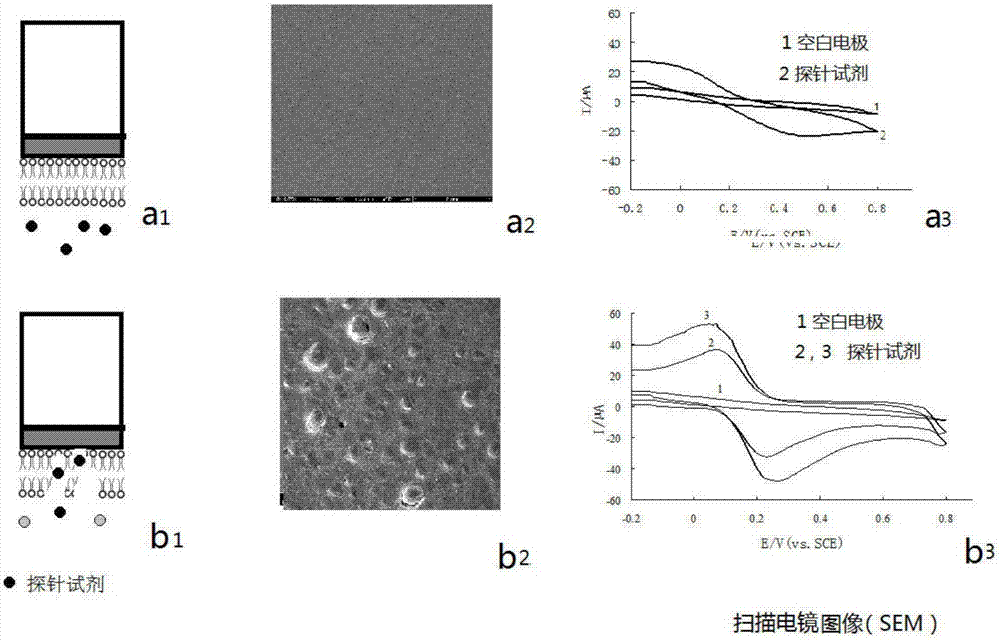Method for determination of free radical over-oxidative capacity of environment
A measurement method and technology of free radicals, applied in the direction of material electrochemical variables, etc., can solve the problems of high cost of use, less monitoring and research of environmental persistent free radicals, and restrictions on the research, monitoring and governance of environmental persistent free radicals
- Summary
- Abstract
- Description
- Claims
- Application Information
AI Technical Summary
Problems solved by technology
Method used
Image
Examples
Embodiment 1
[0027] Coating carbon nano-materials on the screen-printed electrodes and drying to prepare carbon nano-based electrodes; dripping 4.5 μL of lecithin with a concentration of 10 mg / mL and 4.5 μL of cholesteryl cyclohexane with a concentration of 5 mg / mL on the surface of the above-mentioned carbon nano-based electrodes Alkane, a vacuum desiccator protected from light for 1h, after drying, place it in 0.1mol / LKCl solution, scan the -0.2V potential range to be stable by cyclic voltammetry, and place it in a vacuum bag after drying, vacuum, and store at 4℃; Add the eluent to the tested contaminated soil, and place it in the sun to irradiate the reaction, stop the light, take the supernatant and place it in the colorimetric tube, and add 2mL of NaH with a concentration of 0.75mol / L 2 PO 4 And 2mL Na with a concentration of 0.75mol / L 2 HPO 4 Buffer; put in the carbon nano-based electrode, incubate the electrode unit at a constant temperature at 37.5°C for 20 minutes to peroxidize the l...
Embodiment 2
[0029] The carbon nano-materials are coated on the screen-printed electrodes and dried to prepare the carbon nano-based electrodes; on the surface of the carbon nano-based electrodes, 5.5 μL of lecithin at a concentration of 10 mg / mL and 5.5 μL of cholesteryl cyclohexane at a concentration of 5 mg / mL are dripped Alkane, in a light-proof vacuum dryer for 1.5h, after drying, place it in 0.1mol / LKCl solution, scan the 1.0V potential range to be stable by cyclic voltammetry, and place it in a vacuum bag after drying, vacuum, and store at 4℃; Add the eluent to the tested contaminated soil, and place it under the sun to irradiate the reaction, stop the light, take the supernatant and put it in the colorimetric tube, and add 3mL NaH with a concentration of 0.75mol / L 2 PO 4 And 3mL Na with a concentration of 0.75mol / L 2 HPO 4 Buffer; put in the carbon nano-based electrode, incubate the electrode unit at a constant temperature of 37.5°C for 30 minutes to peroxidize the lipid of the electr...
Embodiment 3
[0031] The carbon nano-materials are coated on the screen-printed electrodes and dried to prepare carbon nano-based electrodes; 5 μL of lecithin with a concentration of 10 mg / mL and 5 μL of cholesterol cyclohexane with a concentration of 5 mg / mL are dripped on the surface of the above-mentioned carbon nano-based electrodes. Avoid light in a vacuum desiccator for 1.2h. After drying, place it in 0.1mol / LKCl solution, and scan the 0.5V potential range to be stable by cyclic voltammetry. After drying, place it in a vacuum bag, vacuum, and store at 4℃; Try adding the eluent to the contaminated soil, and place it under the sun to irradiate the reaction, stop the light, take the supernatant and put it in a colorimetric tube, and add 2.5mL NaH with a concentration of 0.75mol / L 2 PO 4 And 2.5mL Na with a concentration of 0.75mol / L 2 HPO 4 Buffer; put in the carbon nano-based electrode, incubate with a stopper at 37.5 ℃ constant temperature to make the electrode unit double-layer phospholi...
PUM
| Property | Measurement | Unit |
|---|---|---|
| Concentration | aaaaa | aaaaa |
Abstract
Description
Claims
Application Information
 Login to View More
Login to View More - R&D Engineer
- R&D Manager
- IP Professional
- Industry Leading Data Capabilities
- Powerful AI technology
- Patent DNA Extraction
Browse by: Latest US Patents, China's latest patents, Technical Efficacy Thesaurus, Application Domain, Technology Topic, Popular Technical Reports.
© 2024 PatSnap. All rights reserved.Legal|Privacy policy|Modern Slavery Act Transparency Statement|Sitemap|About US| Contact US: help@patsnap.com









